On June 13, Dubliners remember Molly Malone, the mysterious fishmonger immortalized in song as she wheeled her barrow through the streets of the capital.
Said to have “died of a fever” in 1669, Molly Malone’s legend has lived on for centuries, blending folklore, music, and local pride into one of Ireland’s most enduring cultural symbols.
While historians debate whether she ever truly existed, her story has become woven into the fabric of Dublin life, and her statue remains one of the city’s most photographed landmarks.
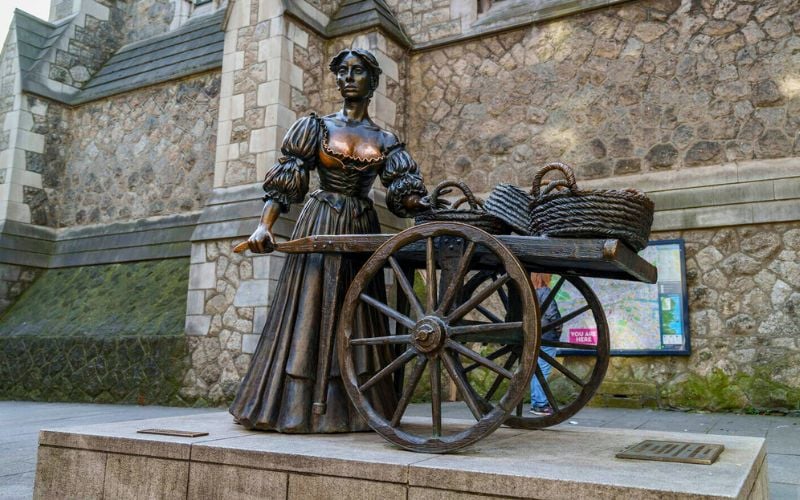
Molly Malone Statue, Suffolk St, Dublin City. (Ireland's Content Pool)
In 1988, the Dublin Millennium Commission formally endorsed a claim that the famous Molly Malone died on June 13, 1669. In turn, June 13 became "Molly Malone Day."
The beloved song "Molly Malone" was for a long time believed to have been published for the first time in the latter half of the 19th century.
The widely-known lyrics of "Molly Malone," attributed to James Yorkston, begin:
In Dublin's fair city,
Where the girls are so pretty,
I first set my eyes on sweet Molly Malone,
As she wheeled her wheel-barrow,
Through streets broad and narrow,
Crying, "Cockles and mussels, alive, alive, oh!"
In 2010, however, The Guardian reported that "a tiny 18th-century book has turned up in Hay-on-Wye [in Wales] containing the earliest known version of Sweet Molly Malone, almost a century older than Dublin's unofficial anthem."
The forgotten-about Molly Malone song was found in "Apollo's Medley," which was printed around 1790 in Doncaster and contained "the most popular and admired songs sung at the Theatre Royal and other public places of amusement."
In the newly-discovered "Molly Malone" song, Molly doesn't have a wheelbarrow, but her admirer has clear designs on her:
Och! I'll roar and I'll groan, My sweet Molly Malone, Till I'm bone of your bone, And asleep in your bed.
The singer worries that Molly may be lonely in her solitary bed:
"Be poison, my drink, If I sleep, snore, or wink, Once forgetting to think, Of your lying alone."
And his devotion is clearly beyond question:
Och! It's how I'm in love,
Like a beautiful dove,
That sits cooing above,
In the boughs of a tree;
It's myself I'll soon smother,
In something or other,
Unless I can bother,
Your heart to love me,
Sweet Molly, sweet Molly Malone,
Sweet Molly, sweet Molly Malone.
This newly-discovered version of the song says the original Molly lived "by the big hill of Howth," which has been a fishing village since Viking times. Other versions mentioning the hill of Howth are known, but none earlier than the early 19th century.
In 1988, a statue of Molly Malone, crafted by sculptor Jeanne Rynhart, was installed at the bottom of Grafton Street (though later moved to Suffolk Street) to celebrate Dublin's millennium.
Dublin wits soon christened it ‘The Tart with the Cart.'
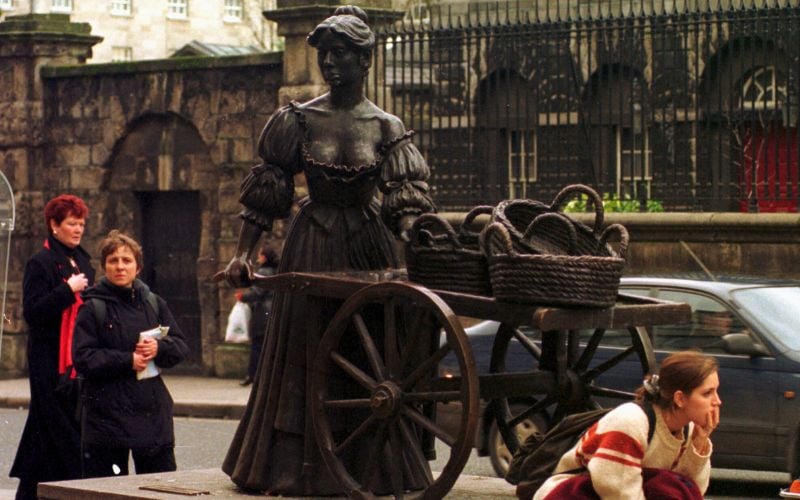
The Molly Malone statue in Dublin in 1998. (RollingNews.ie)
Frank Magee, then the chief executive of Dublin Tourism, told The Guardian in 2010 that the earlier version of "Molly Malone" could be the source of long-time speculation that Molly supplied shellfish by day and special services at night.
"Everyone knows that it is hard to believe that such activities if they took place in Dublin in the late 17th century, were of a mercenary nature.
"The author admits to having imbibed drink, which is another unusual characteristic for a Dubliner, and so I believe his recollection of his night with Molly may have been clouded by alcohol.
"I believe that there is no evidence to suggest that Molly was anything other than a lady of virtue, who was smitten by the writer and may have shared her bed with him."
"Leave Molly mAlone"
At some point, it became an unofficial 'tradition' to rub the breasts of Dublin's Molly Malone statue for good luck, leading to discoloration on the chest of the bronze statue.
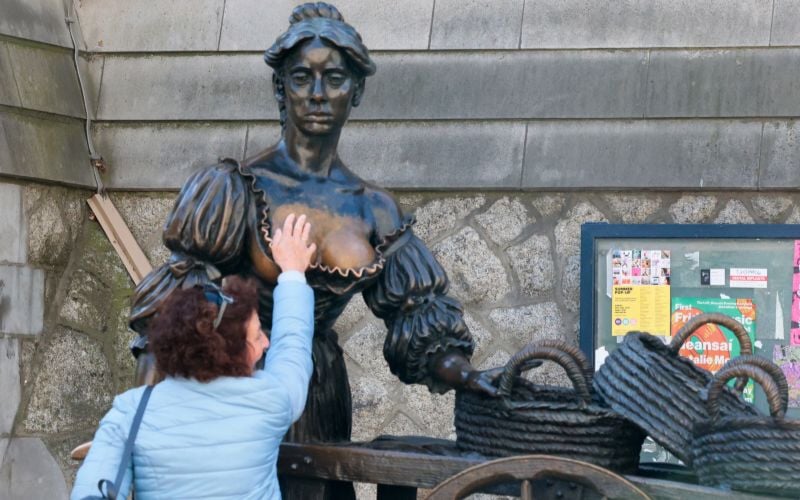
May 2025: A person rubbing the chest of the Molly Malone statue in Dublin. (RollingNews.ie)
In 2024, local woman Tilly Cripwell launched the "Leave Molly mAlone" campaign, calling for the end of a tradition.
In March of this year, Cripwell wrote on social media that Dublin City Council told her it would fully restore the Molly Malone statue so there is no more brassy discoloration on its breasts, and that tourist companies are actively discouraging the rubbing of the statue.
DCC further told Cripwell that it was going to pilot a steward system to prevent repeated damage and unsavoury behaviour.
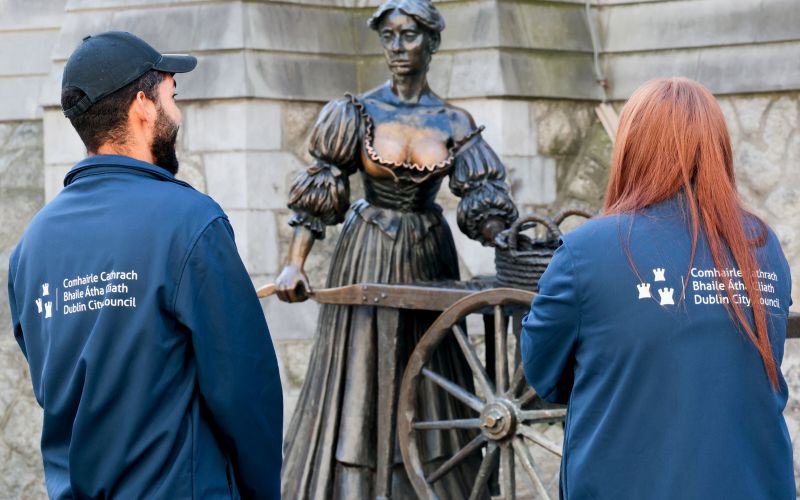
May 2025: Dublin City Council stewards keep an eye on the Molly Malone statue. (RollingNews.ie)
*Originally published in July 2017, last updated in June 2025.
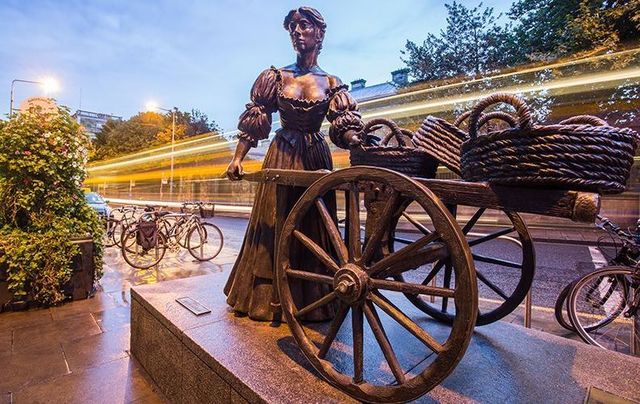

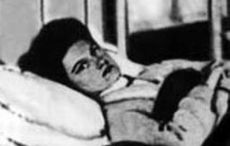
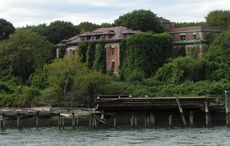
Comments